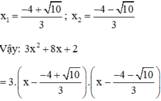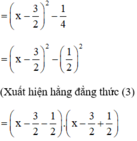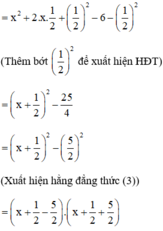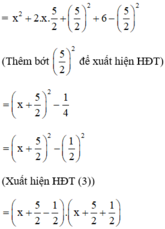phân tích đa thức thành nhân tử
x7+x5+1
x3-x2+x-2
2x3+x2+5x+3
a4(b-c)+b4(c-a)+c4(a+b)
c(c+2b)3-b(2a+b)3
Hãy nhập câu hỏi của bạn vào đây, nếu là tài khoản VIP, bạn sẽ được ưu tiên trả lời.


a) \(x^4+8x+63\)
\(=x^4+4x^3+9x^2-4x^3-16x^2-36x+7x^2+28x+63\)
\(=x^2\left(x^2+4x+9\right)-4x\left(x^2+4x+9\right)+7\left(x^2+4x+9\right)\)
\(=\left(x^2+4x+9\right)\left(x^2-4x+7\right)\)
c) \(\left(x^2+2x+7\right)+\left(x^2-2x+4\right)\left(x^2+2x+3\right)\left(1\right)\)
Ta có : \(x^3-8=\left(x-2\right)\left(x^2+2x+4\right)\)
\(\Rightarrow x^2+2x+4=\dfrac{x^3-8}{x-2}\)
\(\left(1\right)\Rightarrow\left[\left(\dfrac{x^3-8}{x-2}+3\right)\right]+\left(x^2-2x+4\right)\left[\left(\dfrac{x^3-8}{x-2}-1\right)\right]\)
\(=\left[\left(\dfrac{x^3-3x-14}{x-2}\right)\right]+\left(x^2-2x+4\right)\left[\left(\dfrac{x^3-2x-5}{x-2}\right)\right]\)
\(=\dfrac{1}{x-2}\left[x^3-3x-14+\left(x^2-2x+4\right)\left(x^3-2x-5\right)\right]\)

* Chứng minh:
Phương trình a x 2 + b x + c = 0 có hai nghiệm x 1 ; x 2
⇒ Theo định lý Vi-et: 
Khi đó : a.(x – x1).(x – x2)
= a.(x2 – x1.x – x2.x + x1.x2)
= a.x2 – a.x.(x1 + x2) + a.x1.x2
= 
= a . x 2 + b x + c ( đ p c m ) .
* Áp dụng:
a) 2 x 2 – 5 x + 3 = 0
Có a = 2; b = -5; c = 3
⇒ a + b + c = 2 – 5 + 3 = 0
⇒ Phương trình có hai nghiệm 
Vậy: 
b) 3 x 2 + 8 x + 2 = 0
Có a = 3; b' = 4; c = 2
⇒ Δ ’ = 4 2 – 2 . 3 = 10 > 0
⇒ Phương trình có hai nghiệm phân biệt:


Cách 1: Tách một hạng tử thành tổng hai hạng tử để xuất hiện nhân tử chung.
a) x2 – 3x + 2
= x2 – x – 2x + 2 (Tách –3x = – x – 2x)
= (x2 – x) – (2x – 2)
= x(x – 1) – 2(x – 1) (Có x – 1 là nhân tử chung)
= (x – 1)(x – 2)
Hoặc: x2 – 3x + 2
= x2 – 3x – 4 + 6 (Tách 2 = – 4 + 6)
= x2 – 4 – 3x + 6
= (x2 – 22) – 3(x – 2)
= (x – 2)(x + 2) – 3.(x – 2) (Xuất hiện nhân tử chung x – 2)
= (x – 2)(x + 2 – 3) = (x – 2)(x – 1)
b) x2 + x – 6
= x2 + 3x – 2x – 6 (Tách x = 3x – 2x)
= x(x + 3) – 2(x + 3) (có x + 3 là nhân tử chung)
= (x + 3)(x – 2)
c) x2 + 5x + 6 (Tách 5x = 2x + 3x)
= x2 + 2x + 3x + 6
= x(x + 2) + 3(x + 2) (Có x + 2 là nhân tử chung)
= (x + 2)(x + 3)
Cách 2: Đưa về hằng đẳng thức (1) hoặc (2)
a) x2 – 3x + 2

(Vì có x2 và  nên ta thêm bớt
nên ta thêm bớt  để xuất hiện HĐT)
để xuất hiện HĐT)

= (x – 2)(x – 1)
b) x2 + x - 6

= (x – 2)(x + 3).
c) x2 + 5x + 6

= (x + 2)(x + 3).

a: \(x^2-9-x^2\left(x^2-9\right)\)
\(=\left(x^2-9\right)-x^2\left(x^2-9\right)\)
\(=\left(x^2-9\right)\left(1-x^2\right)\)
\(=\left(1-x\right)\left(1+x\right)\left(x-3\right)\left(x+3\right)\)
b: \(x^2\left(x-y\right)+y^2\left(y-x\right)\)
\(=x^2\left(x-y\right)-y^2\left(x-y\right)\)
\(=\left(x-y\right)\left(x^2-y^2\right)\)
\(=\left(x-y\right)\left(x-y\right)\left(x+y\right)=\left(x-y\right)^2\cdot\left(x+y\right)\)
c: \(x^3+27+\left(x+3\right)\left(x-9\right)\)
\(=\left(x+3\right)\left(x^2-3x+9\right)+\left(x+3\right)\left(x-9\right)\)
\(=\left(x+3\right)\left(x^2-3x+9+x-9\right)\)
\(=\left(x+3\right)\left(x^2-2x\right)=x\left(x-2\right)\left(x+3\right)\)
d: \(x^2+5x+6\)
\(=x^2+2x+3x+6\)
\(=x\left(x+2\right)+3\left(x+2\right)=\left(x+2\right)\left(x+3\right)\)
e: \(3x^2-4x-4\)
\(=3x^2-6x+2x-4\)
\(=3x\left(x-2\right)+2\left(x-2\right)\)
\(=\left(x-2\right)\left(3x+2\right)\)
g: \(x^4+64y^4\)
\(=x^4+16x^2y^2+64y^4-16x^2y^2\)
\(=\left(x^2+8y^2\right)^2-\left(4xy\right)^2\)
\(=\left(x^2+8y^2-4xy\right)\left(x^2+8y^2+4xy\right)\)
h: \(a^2+b^2+2a-2b-2ab\)
\(=a^2-2ab+b^2+2a-2b\)
\(=\left(a-b\right)^2+2\left(a-b\right)=\left(a-b\right)\left(a-b+2\right)\)
i: \(\left(x+1\right)^2-2\left(x+1\right)\left(y-3\right)+\left(y-3\right)^2\)
\(=\left(x+1-y+3\right)^2\)
\(=\left(x-y+4\right)^2\)
k: \(x^2\left(x+1\right)-2x\left(x+1\right)+\left(x+1\right)\)
\(=\left(x+1\right)\left(x^2-2x+1\right)\)
\(=\left(x+1\right)\left(x-1\right)^2\)

a) (x - 2)(x - 3). b) 3(x - 2)(x + 5).
c) (x - 2)(3x + 1). d) (x-2y)(x - 5y).
e) (x + l)(x + 2)(x - 3). g) (x-1)(x + 3)( x 2 + 3).
h) (x + y - 3)(x - y + 1).

b, (\(x^2\) - \(xy\) ) + (\(x-y\))
= (\(x-y\)).\(x\) + (\(x-y\))
= (\(x-y\)).(\(x\) + 1)
c, \(x^2\) - 2\(x\) - 15
= (\(x^2\) - 2\(x\) + 1) - 16
= (\(x\) - 1)2 - 42
= (\(x-1-4\)).(\(x-1+4\))
= (\(x-5\)).(\(x+3\))